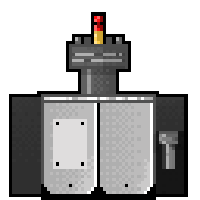
Generates a strong magnetic field when it is in operation.
Vacuum pumps are tools used to create very low pressure conditions, almost absolute vacuum inside a sealed volume, such as a particle accelerator. Some vacuum pumps work generating strong electric and magnetic fields.
A vacuum pump is a widely used instrument in physics laboratories, as many experiments require working under very low pressure conditions. For example, the LUNA experiment at LNGS uses a particle accelerator (See accelerator), inside which a charged particle beam must travel compactly to a target. It is crucial to minimize the presence of gas molecules (air in this case) along the beam path that would otherwise collide with the beam projectiles, causing energy loss and dispersion of the particles in space. The basic mechanism of a vacuum pump operation is very simple. The pump is connected to the container filled with, let’s say, 1 cubic metre of gas. Inside the pump – which is initially under vacuum conditions – there is a barrier which is removed at this point, so that the gas is free to expand into a larger volume (that of the container plus part of the pump), which is for example twice as large. Then the barrier is re-positioned: now we have two volumes of one cubic metre each in which there is about half the initial amount of gas; the volume filled with gas from the pump is then mechanically reduced to almost zero and the gas thus compressed is released to the outside. The process is repeated many times, reducing more and more the quantity of gas inside the container. This procedure is followed by the simplest vacuum pumps, such as rotary pumps, which can create low to medium vacuum conditions (i.e. up to about 10^-6 atmospheres, corresponding to a pressure one million times lower than atmospheric pressure). More sophisticated vacuum pumps can create ultra-high vacuum conditions (up to about 10^-14 atmospheres). One of these is the ion vacuum pump. Inside this instrument, the gas to be removed is ionized (electrons are removed from atoms, generating positive ions) and the ions are captured by a solid electrode. The space in which this happens is formed by a series of electrically insulated cylindrical anodes (electrodes with positive potential) placed between two titanium plates that act as a cathode (electrodes with negative potential); the whole is in turn placed inside a magnet that generates a magnetic field parallel to the axes of the cylinders. An electric discharge produces free electrons that are attracted and trapped by the electric field inside the cylinders and due to the magnetic field they start to rotate around the axis of the cylinders. The rotating cloud of electrons thus formed collides with the gas molecules introduced into the chamber, tearing other electrons from them, thus creating positively charged ions. Due to the effect of the electric field, the ions are accelerated at high speed towards the cathode, where they impact and become absorbed. The magnetic field necessary for this process has an intensity of about 0.1 Tesla. It may not seem much, but in reality, this is a remarkable value: by comparison, the Earth's magnetic field at the equator is less than about four orders of magnitude (10,000 times, 1000 T), while the super magnets deflecting the particle beams at the Geneva Cern LHC accelerator generate a magnetic field two orders of magnitude (10 Tesla) greater. This is why if the shielding of the magnets of an ion vacuum pump is not perfect, it may represent a source of interference when placed near a small accelerator, not only in a video game, but also in reality.

Discover the experiments and help the alien to get back home!
Play now